by Billy Sweet | Mar 31, 2020 | Chimney Anatomy
Your chimney may be the biggest system in your home besides the central air and heating unit and there’s a lot that can go wrong with it. Because it’s so big and can cause big problems for your home, it’s important to understand just what makes up the chimney system, how it works, and how it can go wrong.
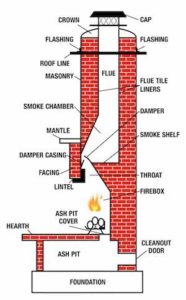 Parts of the Chimney
Parts of the Chimney
From bottom to top, there are many parts and materials that make up a fireplace and chimney system. The terms ‘fireplace’ and ‘chimney’ are often used interchangeably, and they work together to get the job done. What we know as the fireplace is actually called the firebox, and what we know as the chimney is actually the flue. These are only two parts of a very large system that must be built and maintained properly. Only then will the system work efficiently and safely.
Foundation – Just as the house itself sits on a foundation that holds it up and prevents settlement and shifting as seasons and weather change the soil, the chimney requires a foundation. Oftentimes this foundation is built when the home is built, but not always.
Ash Dump – Some, but not all, chimneys have an ash dump. This is a space beneath the firebox where ashes can be pushed and stored to cool and collect over time. A chimney sweep can remove these ashes as needed through a cleanout door near the foundation—a service that usually isn’t required for several years.
Hearth – The hearth is the floor of the firebox which usually extends from the back of the fireplace out into the room a bit and is made of a particular firebrick and refractory mortar that protects against heat transfer from the fire.
Firebox – The space where the fire sits and burns is called the firebox. It endures the highest temperatures for the longest periods but receives the least attention. The firebox is constructed of firebricks and refractory mortar.
Damper – The damper is a mechanism, usually made of metal, installed at the top of the firebox and opens and closes the flue opening. When the damper is closed, very little air moves through the chimney system. When the flue is open, air flows freely.
Smoke Chamber – The space above the firebox is called the smoke chamber—so named because this is where the particles and gases mingle with the heat to rise up the chimney. It is shaped like an inverted funnel to direct smoke upward and into the flue. Beneath the smoke chamber, there is a shelf (called the smoke shelf) designed to prevent smoke from falling back into the firebox and into the home. The walls of the smoke chamber should be at certain angles and smooth.
Flue – The flue is the interior vent by which smoke and gases travel out of the home. The surface of the flue should be covered with a liner that keeps heat and corrosive chemicals from damaging or moving through the masonry and gives it a seamless, smooth surface for optimum airflow.
Masonry Crown – At the top of the chimney there is a ceiling that extends from the flue opening to the edge of the chimney. The crown is made out of durable material that can withstand harsh temperatures, sunlight, and precipitation. It is also made at a slant so that water runs away from the flow and onto a drip edge, where it drips down onto the flashing at the roof instead of running down the masonry.
Chimney Cap – The chimney cap is the roof of the chimney system. It keeps water, animals, wind, and weather out. The cap is necessary to prevent chimney water damage and animal intrusion. It is often made of copper or stainless steel.
Common Chimney Problems
Even a well-constructed chimney can become damaged over time—especially through particularly rough winters or when subjected to coastal air and moisture.
- Spalling masonry can be particularly devastating to chimneys that stand in coastal regions. This is when the mortar cracks and falls away, causing bricks to loosen and take on water.
- Leaky chimneys can lead to damaged parts of the chimney, but also water damage throughout the house. A chimney leak can occur in any season and cause damage year-round.
- Smoky fireplaces are usually caused by an obstruction, draft issue, or even the wrong firewood being burned in the fireplace! A smoky fireplace doesn’t always require a repair but should always be troubleshot and a professional should be called if the problem persists.
- Liner damage is most often due to an old clay tile liner becoming worn out and breaking apart. You might find pieces of clay tile in your firebox or notice problems like masonry that is hot to the touch. Liner damage can also be caused by a dirty flue or a flue fire.
Whether your system is old or new, whether you have a fireplace, a stove, or an insert, whether you burn wood, pellets, or gas, your chimney is important. It can be a great asset, but can also be very dangerous. Make sure you know the ins and outs of chimney function and maintenance. Make sure your chimney system is safe and efficient. It will work better and for longer.
Call and schedule services with Billy Sweet Chimney Sweep today by calling 617-469-4528
by Billy Sweet | Sep 27, 2016 | Chimney Masonry Maintenance
There are a lot of things that can go wrong during the life of your chimney including age, natural disasters, and more. The most detrimental thing that can happen to your masonry chimney is water penetration. Your chimney is constructed of a variety of masonry and metal materials, all of which are adversely affected by water. Therefore it is vital to keep them maintained, which most importantly includes waterproofing.
Professional Services, Professional Standards
When you trust a professional with your chimney, you get what you pay for. There are waterproofing products and services that are specially formulated for chimney use. Keep in mind they should only be applied by a professional who is experienced and educated!
Common waterproofing services that Billy Sweet offers include:
- Sealant
These are professional-grade chemical products that should only be applied by a CSIA Certified Chimney Sweep® (CCS). This breathable sealant seals your chimney from water penetration from the outside. Also, the sealant still allows the vapors and smoke to be released through the porous masonry from the inside. This process is important and should not be missed while waterproofing your chimney.
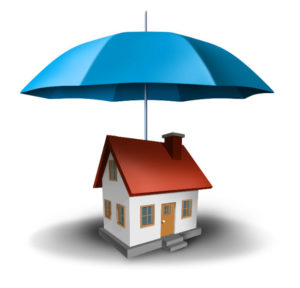 Flashing
Flashing
Flashing is made up of thin sheets of metal, placed strategically and specifically for your chimney to keep water out. It is placed around the intersection of the chimney and roof. This can be very easily damaged over time. Only a professional chimney sweep knows the best material and best placement of the metal sheets for your chimney and slant of your roof. Choosing the wrong material or placing them improperly can cause shifting and rusting. This allows your chimney to leak.- Chimney Caps
Although they may seem optional, the chimney cap is essential for chimney efficiency and the life of the chimney. It also keeps your family and property safe. The chimney cap keeps rain water and snow from falling into your chimney flue, while still allowing vapors out. The chimney cap can often be damaged or installed improperly, allowing water to fall into the chimney. This can result in rusting parts and damaging masonry through a process of freezing and thawing. Chimney caps also keep wild life out of your chimney, which can cause blockage and fire.
- Chimney Crown
The chimney crown works with the chimney cap to keep water from entering the chimney flue. The chimney crown is a concrete piece that reaches from the flue across the top of the chimney to the edge. It is constructed specifically for your chimney, with a slant to direct water away from the flue and onto the roof. If your chimney sweep reports only minor damage, cracks and pits in your crown, he can recommend and apply a crown coat sealant that will repair and prolong your crown’s life. If more extensive damage exists, your chimney sweep can remove the damaged crown and construct a new, durable crown that will last for years.
When Should You Waterproof?
To avoid damage, high cost repairs, and loss of life and property you should make chimney maintenance a priority. Scheduling your regular chimney sweeps and yearly inspections is the best way to catch a problem before it becomes a problem. By the time a homeowner notices a leak, stain, spalling, or other signs of a leaky chimney there is probably extensive unseen damage. A Billy Sweet Chimney Sweep is experienced and trained to notice risk factors and issues that pose a risk to your chimney system. We put safety first always, and we’re certified to get the job done right.
Call Billy Sweet today or contact us online to schedule an appointment!
by Billy Sweet | Jun 8, 2016 | Chimney Maintenance
Chimney caps are the most inexpensive way to prevent water penetration to the the chimney system. 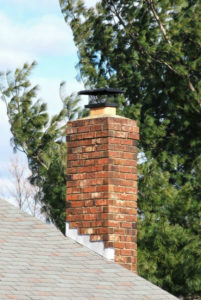 The chimney cap covers the flue opening to keep the weather out, and here in New England we get a fair share of weather. Although the chimney cap is sometimes called a rain cover, it is essential for winter weather as well.
The chimney cap covers the flue opening to keep the weather out, and here in New England we get a fair share of weather. Although the chimney cap is sometimes called a rain cover, it is essential for winter weather as well.
Keep the Outside Out and the Inside In
—Weather
The average snowfall for one year is enough to wreak havoc on a chimney, especially in New England. The process of freezing, thawing, and expanding through one cycle of seasons causes extensive damage to the chimney system. The chimney cap prevents rain water and snow from entering the flue opening.
—Wildlife
Throughout the seasons various animals like to climb into chimneys and nest in the safety and warmth there. Throughout the year a chimney can become a habitat for small animals like squirrels, raccoons, and birds. Some animals, depending on the location, are protected, like the Chimney Swift. If a Chimney Swift nests in your chimney, it cannot be removed, and the chimney cannot be cleaned or used until the young birds have left the nest.
—Sparks
When a fire is burning particularly hot, it’s common for sparks and other byproducts to fly up through the flue. Without a chimney cap these sparks can ignite debris on the roof, or in a yard below or nearby.
When to Call a Professional
The Chimney Safety Institute of America (CSIA) recommends regular chimney sweeps and annual inspections for safe and efficient use of fireplace and chimney systems. It’s at these appointments that a professional would notice a missing, incorrectly installed, or damaged chimney cap.
Other good times to make an appointment with a CSIA Certified Chimney Sweep® (CCS) are after the sale or transfer of a house, when fuel type is changed, or when changes are made to the system (including natural disasters and fire damage).
A Billy Sweet Chimney Sweep knows what is expected of chimneys in the Boston area. We pride ourselves on expert training and experience that puts our sweeps at the top of the industry for chimney maintenance. We offer waterproofing services and repairs to leaky chimneys, at fair rates and professional service.
Water Damage
Billy Sweet Chimney Sweeps make it our top priority to keep your fireplace system working and safe for your family, home, or business. When water is allowed to penetrate the chimney system it can affect everything, as the chimney is a system of many parts. Water damage can cause, rust, rot, deterioration, cracks, decay, stains, and more.
Call a Billy Sweet Chimney Sweep today or make an appointment online to check your chimney cap.
by Billy Sweet | Jul 6, 2015 | Capped Chimney
When you consider the safety and efficiency of your fireplace unit, you might forget one of its most important elements: your chimney cap. Many homeowners and consumers fail to recognize the vital protective measures offered by a functioning chimney cap; they might also be unfamiliar with the tell-tale signs of an issue with their caps.
A chimney cap is a small, relatively inexpensive addition to your home’s fireplace system, yet offers an important degree of protection from various threats.
A chimney cap prevents critters, wind-borne debris, moisture and other elements from entering your chimney and home. It also prevents burning embers from escaping through your chimney and landing on your roof, causing a potential fire. It’s important to ensure that your chimney cap is in proper working order before colder weather arrives.
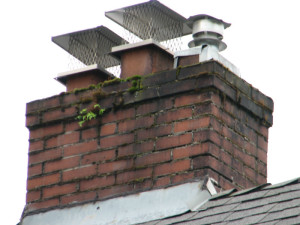
Here are a few signs that your chimney cap needs repair or replacement.
Moisture
Moisture causes more damage to fireplaces each year than mismanaged fires, and, left unchecked, has the potential to cause serious, irreparable damage to your unit and home.
If you notice dripping or pooling water in or around your fireplace, moisture has gained an access point in your chimney, and you need an immediate inspection. A working chimney cap will prevent excess moisture from accumulating in your chimney and home.
Drafting Problems
If you notice that your chimney isn’t venting properly or is sending excess smoke into your home, you might have a broken chimney cap that is allowing blockages to build up in your flue.
If your chimney cap becomes clogged with creosote or debris, it won’t vent properly and will send smoke and particulates from the burning fire back into your home.
There are many dangers attached breathing this contaminated air, including smoke damage to your home and severe illness.
Critters or Debris Entering Your Fireplace
Another of the main functions of your chimney cap is to prevent animals or debris from entering your chimney and causing blockages or creating disturbances in your home.
Squirrels, raccoons and birds will often mistake an uncapped or open chimney for a hollow tree; they often get stuck inside the chimney or decide to build a nest in the space, creating a very dangerous situation for themselves and the homeowners.
If you hear frantic scratching or clawing in your fireplace, you may have an issue with a trapped or nesting animal. This is a sign that you chimney cap has significant damage and needs to be replaced or repaired.
Additionally, if you notice leaves, sticks or other debris gathering in your fireplace, your chimney cap is not working properly and needs to be repaired or replaced.
Ensuring That Your Chimney Cap Is In Working Order
If you’ve noticed any of these issues with your fireplace, it’s important that you have your chimney cap inspected by a professional.
A certified chimney inspector will ensure that your chimney cap is in working order, that there are no issues with venting and that you can safely use your fireplace without fear of hazards.
It is recommended that you have your chimney inspected once a year by a certified chimney sweep. Because fall is the most popular time for chimney inspections, you might consider making your appointment before the rush, to avoid delays or wait times.
Billy Sweet Chimney Sweep serves all of the Boston area with professional, certified chimney inspection and installation services.
Call today for an appointment.
by Billy Sweet | Feb 11, 2015 | Working In Boston
Working in Boston links you to the history and entrepreneurial spirit on which American Free Enterprise was built. Not only is Boston the birthplace of American freedom, throughout the years, Boston has proven to be a leader in national and international commerce. That’s why Billy Sweet Chimney Sweep is so proud we are part of the Boston business community.
Boston Harbor is the oldest in the country. John Smith discovered the port in 1614. The harbor is synonymous with the Boston Tea Party. By the 1660s Boston Harbor was the port for all arriving cargo ships bringing goods to New England. Today, Boston Harbor remains an important shipping port and many of the job opportunities are related to the maritime activities associated with the Port of Boston.
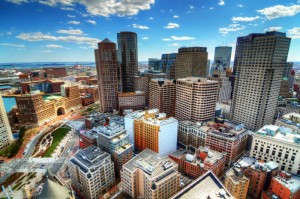
In addition to its strategic waterfront location, Boston has also grown into a technological, educational, and health care mecca for local, regional, national, and international businesses. As the capital of Massachusetts, there are civil and political employment opportunities, both local and state. At the crux of all business, is independent business. Boston is the place for entrepreneurs to build deep roots and showcase their talents and passions by providing products and services to those who live and work in the Boston area. There are over 800 restaurants in Boston and less than 40 of them are considered “fast food”. That means restaurants for lunch, after work get-togethers, dinner, and weekend food and entertainment venues are abundant for foodies and wait staff.
There are many characteristics that make working in Boston so special.
First and foremost are the people. Boston is a melting pot. Hardworking, determined settlers from across the globe came to Boston over the years in order to build a better life. Each generation has built on that foundation while growing Boston into a progressive leader of commerce in the world.
Boston is a city of education.
The students of Boston’s most prestigious colleges and universities make Boston one of the youngest metropolitan areas in the country. Working in Boston means your business is patronized by the students, faculty and administrators. As a resident or visitor to Boston you can enjoy sports, theatre, art, community education and much more as a result of the community outreach programs sponsored by the 53 colleges and universities in the Boston area. Nine out of 27 of Boston’s public schools were honored with the bronze, silver, or gold rankings by U.S. News & World Report thanks to their educators and school district administration. The first public school in the United States opened in 1635, Boston Latin, and is still open today.
Boston is a city of firsts.
- First College (Harvard, 1636)
- First Subway (1897)
- First Public Park (1639)
- First Organ Transplant (Kidney, 1954)
- First City Police Department (1837)
- First Dunkin Donut (1950)
- First Newspaper (Boston Globe, 1704)
- First Microwave Oven (1947)
- First Ball Park (Fenway, 1912)
- In light of the recent terrorist attacks in Boston, our first responders also receive our accolades.
All these, and many more firsts, reinforce why it is so good to work in Boston. For more firsts in Boston click here.
Sports in Boston are a source of employment and after work recreation.
The Celtics, Red Sox, Bruins, and Patriots mean sports lovers have the ability to cheer for their favorite team during every season. Dating as far back as opening day at Fenway, attending Opening Days and special games have even been the reason many employees have called in “sick”. There is nothing better than relaxing and supporting your favorite team! The staff who support the stadiums, teams, and concessions give our athletes and the fans a unique and unprecedented experience. (As do our renowned craft beer breweries.)
Boston Employment An All-Time High
There are over 3.4 million people working in Boston. Those who are currently working or look to work in Boston, are encouraged by this summary on the City of Boston’s website. “With a strong economy, safe streets and a diverse workforce, Boston is poised for continued success in fostering new enterprise throughout the city. Increasingly, companies are discovering new market opportunities in urban neighborhoods where density of purchasing power, investment in new infrastructure and access to employees form a framework for growth.”
We love working in Boston, the people, the resources, the transportation, the culture, the geography and so much more gives those who work in Boston a huge advantage and quality of life over America’s other big cities!
 Parts of the Chimney
Parts of the Chimney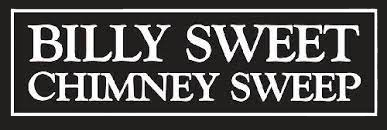
 Flashing
Flashing The chimney cap covers the flue opening to keep the weather out, and here in New England we get a fair share of weather. Although the chimney cap is sometimes called a rain cover, it is essential for winter weather as well.
The chimney cap covers the flue opening to keep the weather out, and here in New England we get a fair share of weather. Although the chimney cap is sometimes called a rain cover, it is essential for winter weather as well.
